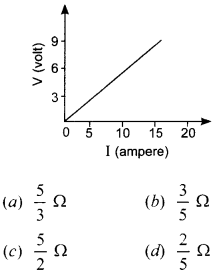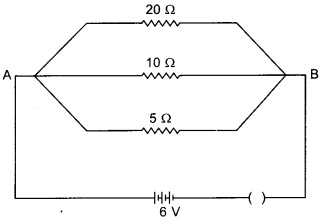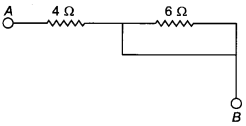MCQs for Class 10 Science Chapter 12 Electricity
MCQs for Class 10 Science Chapter 12 Electricity: In this article, we have covered all the important MCQs for Free for Class 10 Term 1 2021-22 Board Exams. In accordance with the latest pattern, Padhle is here with MCQ Questions for Class 10.
- Get MCQs for other Class 10 Chapters
- Get NCERT Solutions Class 10 Chapters
- Get Notes, PYQs, Free E-Books, and other material for Class 9
- Get Notes, PYQs, Free E-Books, and other material for Class 10
- Join our Telegram Channel for Latest Updates here
[adinserter block=”3″]
[twy_show_add_bookmark]
MCQ for Class 10 Science Chapter 12 Electricity
Question 1:
Which of the given is the SI Unit of Electric Current?
(a) Ohm
(b) Ampere
(c) Volt
(d) Faraday
Answer: (b) Ampere
Question 2:
What is the amount of current flowing through an electric press, if the amount of charge passing through a conductor in 10 minutes is 300 C?
(a) 30 A
(b) 0.3 A
(c) 0.5 A
(d) 5 A
Answer: (c) 0.5 A
Question 3:
When electric current is passed, electrons move from:
(a) high potential to low potential.
(b) low potential to high potential.
(c) in the direction of the current.
(d) against the direction of the current.
Answer: (b) low potential to high potential.
Question 4:
A wire of length /, made of material resistivity ρ is cut into two equal parts. The resistivity of the two parts are equal to,
(a) ρ
(b) \(\frac{\rho}{2}\)
(c) 2 ρ
(d) 4 ρ
Answer: (a) ρ
Question 5:
The hindrance presented by material of conductor to the smooth passing of electric current is known as:
(a) Resistance
(b) Conductance
(c) Inductance
(d) None of these
Answer: (a) Resistance
Question 6:
An electrical appliance has a resistance of 25 Ω. When this electrical appliance is connected to a 230 V supply line, the current passing through it will be:
(a) 0.92 A
(b) 2.9 A
(c) 9.2 A
(d) 92 A
Answer: (c) 9.2 A
Question 7:
The heating element of an electric iron is made up of:
(a) copper
(b) nichrome
(c) aluminium
(d) iron
Answer: (b) nichrome
Question 8:
The temperature of a conductor is increased. The graph best showing the variation of its resistance is
Answer: (a)
Question 9:
A fuse wire is inserted in which wire?
(a) Live wire
(b) In the neutral wire
(c) In the earth wire
(d) May be connected in any line
Answer: (a) Live wire
Question 10:
When a 4 Ω resistor is connected across the terminals of a 2 V battery, the number of coulombs passing through the resistor per second is:
(a) 0.5
(b) 1
(c) 2
(d) 4
Answer: (a) 0.5
Question 11:
The electrical resistance of insulators is
(a) high
(b) low
(c) zero
(d) infinitely high
Answer: (d) infinitely high
Question 12:
A battery of 10 volt carries 20,000 C of charge through a resistance of 20 Ω. The work done in 10 seconds is
(a) 2 × 103 joule
(b) 2 × 105joule
(c) 2 × 104 joule
(d) 2 × 102 joule
Answer: (b) 2 × 105joule
Question 13:
The rate of flow of an electric charge is known as :
(a) Electric potential
(b) Electric conductance
(c) Electric current
(d) None of these
Answer: (c) Electric current
Question 14:
Keeping the potential difference constant, the resistance of the circuit is halved. The current will become:
(a) One-fourth
(b) Four times
(c) Half
(d) Double
Answer: (d) Double
Question 15:
Electrical resistivity of any given metallic wire depends upon
(a) its thickness
(b) its shape
(c) nature of the material
(d) its length
Answer: (c) nature of the material
Question 16:
A boy records that 4000 joule of work is required to transfer 10 coulomb of charge between two points of a resistor of 50 Ω. The current passing through it is
(a) 2 A
(b) 4 A
(c) 8 A
(d) 16 A
Answer: (c) 8 A
Question 17:
The instrument used for measuring electric current is :
(a) Ammeter
(b) Galvanometer
(c) Voltmeter
(d) Potentiometer
Answer: (a) Ammeter
Question 18:
If in the given arrangement, the three resistors are to be replaced by a single resistor. What will be the value of this resistor?

(a) 4Ω
(b) 6Ω
(c) 9Ω
(d) 18Ω
Answer: (c) 9Ω
Question 18:
Electric power is inversely proportional to
(a) resistance
(b) voltage
(c) current
(d) temperature
Answer: (a) resistance
Question 19:
The resistance whose V-I graph is given below is
Answer: (b)
Question 20:
The amount of work done in joules, when one unit electric charge moves from one point to another point in an electric circuit is called :
(a) Electric current
(b) Electric resistance
(c) Electric conductance
(d) Potential difference
Answer: (d) Potential difference
Question 21:
The potential difference across the 3 Ω resistor in the following diagram is:

(a) 1/9 V
(b) 1/2 V
(c) 2V
(d) 1V
Answer: (d) 1V
Question 22:
What is the commercial unit of electrical energy?
(a) Joules
(b) Kilojoules
(c) Kilowatt-hour
(d) Watt-hour
Answer: (c) Kilowatt-hour
Question 23:
To get 2 Ω resistance using only 6 Ω resistors, the number of them required is
(a) 2
(b) 3
(c) 4
(d) 6
Answer: (b) 3
Question 24:
The unit of potential difference is :
(a) Volt
(b) Ohm
(c) Ampere
(d) Faraday
Answer: (a) Volt
Question 25:
V1, V2 and V3 are the potential differences across the 1Ω, 2Ω and 3Ω resistors in the following diagram, and the current is 5A.

Which of the following shows the correct values of V1, V2 and V3 measured in volts?
(a) V1 =1, V2 = 2 and V3 = 3
(b) V1 =5, V2 = 10 and V3 = 15
(c) V1 =5, V2 = 2.5 and V3 = 1.6
(d) V1 =4, V2 = 3 and V3 = 2
Answer: (b) V1 =5, V2 = 10 and V3 = 15
Question 26:
Three resistors of 1 Ω, 2 ft and 3 Ω are connected in parallel. The combined resistance of the three resistors should be
(a) greater than 3 Ω
(b) less than 1 Ω
(c) equal to 2 Ω
(d) between 1 Ω and 3 Ω
Answer: (b) less than 1 Ω
Question 27:
Two devices are connected between two points say A and B in parallel. The physical quantity that will remain the same between the two points is
(a) current
(b) voltage
(c) resistance
(d) None of these
Answer: (b) voltage
Question 28:
The relation between potential difference (V) and current (I) is :
(a) V α I2
(b) V α 1/I
(c) V2 α I
(d) V α I
Answer: (d) V α I
Question 29:
A wire of resistance R1 is cut into five equal pieces. These five pieces of wire are then connected in parallel. If the resultant resistance of this combination be R2, then the ratio R1/ R2 is:
(a) 1/25
(b) 1/5
(c) 5
(d) 25
Answer: (d) 25
Question 30:
An electric bulb is connected to a 220V generator. The current is 0.50 A. What is the power of the bulb?
(a) 440 W
(b) 110 W
(c) 55 W
(d) 0.0023 W
Answer: (b) 110 W
Question 31:
Calculate the current flows through the 10 Ω resistor in the following circuit.
(a) 1.2 A
(b) 0.6 A
(c) 0.2 A
(d) 2.0 A
Answer: (b) 0.6 A
Question 32:
The relation between potential difference (V) and current (I) was discovered by :
(a) Newton
(b) Ampere
(c) Ohm
(d) Volta
Answer: (c) Ohm
Question 33:
Two appliances of rating 200 watt-250 volts and 100 watt-250 volts are joined in series to a 250 volts supply. Total power consumed in the circuit is
(a) 46 watt
(b) 67 watt
(c) 10 watt
(d) 30 watt
Answer: (b) 67 watt
Question 34:
The resistivity of insulators is of the order of
(a) 10-8 Ω-m
(b) 101 Ω-m
(c) 10-6 Ω-m
(d) 106 Ω-m
Answer: (a) 10-8 Ω-m
Question 35:
Two resistors are connected in series gives an equivalent resistance of 10 Ω. When connected in parallel, gives 2.4 Ω. Then the individual resistance are
(a) each of 5 Ω
(b) 6 Ω and 4 Ω
(c) 7 Ω and 4 Ω
(d) 8 Ω and 2 Ω
Answer: (b) 6 Ω and 4 Ω
Question 36:
The obstruction offered by material of conductor to the passage of electric current is known as :
(a) Resistance
(b) Conductance
(c) Inductance
(d) None of these
Answer: (a) Resistance
Question 37:
When a current ‘I’ flows through a resistance ‘R’ for time ‘t’ the electrical energy spent is given by
(a) IRt
(b) I2Rt
(c) IR2t
(d) I2R/t
Answer: (b) I2Rt
Question 38:
In the given figure, the resistors

(a) 6 Ω, 3 Ω and 9 Ω are in series
(b) 9 Ω and 6 Ω are in parallel and the combination is in series with 3 Ω
(c) 3 Ω, 6 Ω and 9 Ω are in parallel
(d) 3 Ω and 6 Ω are in parallel and the combination is in series with 9 Ω
Answer: (d) 3 Ω and 6 Ω are in parallel and the combination is in series with 9 Ω
Question 39:
Two electric bulbs have resistances in the ratio 1:2. If they are joined in series, the energy consumed in them is in the ratio.
(a) 2:1
(b) 1:2
(c) 4:1
(d) 1:1
Answer: (b) 1:2
Question 40:
You are given four ammeters A, B, C and D having least counts mentioned below:
(I) Ammeter A with least count 0.25 A
(II) Ammeter B with least count 0.5 A
(III) Ammeter C with least count 0.05 A
(IV) Ammeter D with least count 0.1 A
Which of the ammeters would you prefer for doing an experiment to determine the equivalent resistance of two resistances most accurately, when connected in parallel?
(a) Ammeter A
(b) Ammeter B
(c) Ammeter C
(d) Ammeter D
Answer: (c) Ammeter
Question 41:
At a given time, a house is supplied with 100 A at 220 V. How many 75 W, 220 V light bulbs could be switched on in the house at the same time (if they are all connected in parallel)?
(a) 93
(b) 193
(c) 293
(d) 393
Answer: (c) 293
Question 42:
If the current flowing through a fixed resistor is halved, the heat produced in it will become:
(a) One-fourth
(b) One-half
(c) Double
(d) Four times
Answer: (a) One-fourth
Question 43:
Coulomb is the SI unit of:
(a) charge
(b) current
(c) potential difference
(d) resistance
Answer: (a) charge
Question 44:
1 mV is equal to:
(a) 10 volt
(b) 1000 volt
(c) 10-3 volt
(d) 10-6 volt
Answer: (c) 10-3 volt
Question 45:
Electric potential is a:
(a) scalar quantity
(b) vector quantity
(c) neither scalar nor vector
(d) sometimes scalar and sometimes vector
Answer: (a) scalar quantity
Question 46:
100 J of heat is produced each second in a 4Ω resistor. The potential difference across the resistor will be:
(a) 30 V
(b) 10 V
(c) 20 V
(d) 25 V
Answer: (b) 10 V
Question 47:
Which of the following gases are filled in electric bulbs?
(a) Helium and Neon
(b) Neon and Argon
(c) Argon and Hydrogen
(d) Argon and Nitrogen
Answer: (d) Argon and Nitrogen
Question 48:
1 kWh = ……….. J
(a) 3.6 × 10-6 J
(b) 13.6 × 106 J
(c) 3.6 × 106 J
(d) 13.6 × 10-6 J
Answer: (c) 3.6 × 106 J
Question 49:
If R1 and R2 be the resistance of the filament of 40 W and 60 W respectively operating 220 V, then
(a) R1 < R2
(b) R2 < R1
(c) R1 = R2
(d) R1 ≥ R2
Answer: (b) R2 < R1
Question 50:
The resistance of hot filament of the bulb is about 10 times the cold resistance. What will be the resistance of 100 W-220 V lamp, when not in use?
(a) 48 Ω
(b) 400 Ω
(c) 484 Ω
(d) 48.4 Ω
Answer: (c) 484 Ω
Question 51:
A coil in the heater consume power P on passing current. If it is cut into halves and joined in parallel, it will consume power
(a) P
(b) \(\frac{P}{2}\)
(c) 2P
(d) 4P
Answer: (d) 4P
Question 52:
A fuse wire repeatedly gets burnt when used with a good heater. It is advised to use a fuse wire of
(a) more length
(b) less radius
(c) less length
(d) more radius
Answer: (d) more radius
Question 53:
A cooler of 1500 W, 200 volt and a fan of 500 W, 200 volt are to be used from a household supply. The rating of fuse to be used is
(a) 2.5 A
(b) 5.0 A
(c) 7.5 A
(d) 10 A
Answer: (d) 10 A
Question 54:
The effective resistance between A and B is
(a) 4Ω
(b) 6Ω
(c) May be 10 Ω
(d) Must be 10 Ω
Answer: (a) 4Ω
Question 55:
A current of 1 A is drawn by a filament of an electric bulb. Number of electrons passing through a cross-section of the filament in 16 seconds would be roughly [NCERT Exemplar Problems]
(a) 1020
(b) 1016
(c) 1018
(d) 1023
Answer: (a) 1020
Question 56:
A car headlight bulb working on a 12 V car battery draws a current of 0.5 A. The resistance of the light bulb is:
(a) 0.5 Ω
(b) 6 Ω
(c) 12 Ω
(d) 24 Ω
Answer: (d) 24 Ω
Question 57:
The other name of potential difference is:
(a) Amphereage
(b) Wattage
(c) Voltage
(d) Potential energy
Answer: (c) Voltage
Question 58:
Keeping the potential difference constant, the resistance of a circuit is doubled. The current will become:
(a) Double
(b) Half
(c) One-fourth
(d) Four times
Answer: (b) Half
Question 59:
An electric fuse works on the:
(a) Chemical effect of current
(b) Magnetic effect of current
(v) Lighting effect of current
(d) Heating effect of current
Answer: (d) Heating effect of current
Question 60:
In a filament type light bulb, most of the electric power consumed appears as:
(a) Visible light
(b) Infra-red rays
(c) Ultraviolet rays
(d) Fluorescent light
Answer: (b) Infra-red rays
Click Here to Download the PDF of MCQs for this Chapter
For More Content related to Class 10 –
- Get MCQs for other Class 10 Chapters
- Get NCERT Solutions Class 10 Chapters
- Get Notes, PYQs, Free E-Books, and other material for Class 9
- Get Notes, PYQs, Free E-Books, and other material for Class 10
- Join our Telegram Channel for Latest Updates here
[adinserter block=”3″]










